Hide and seek with free roaming rhinos
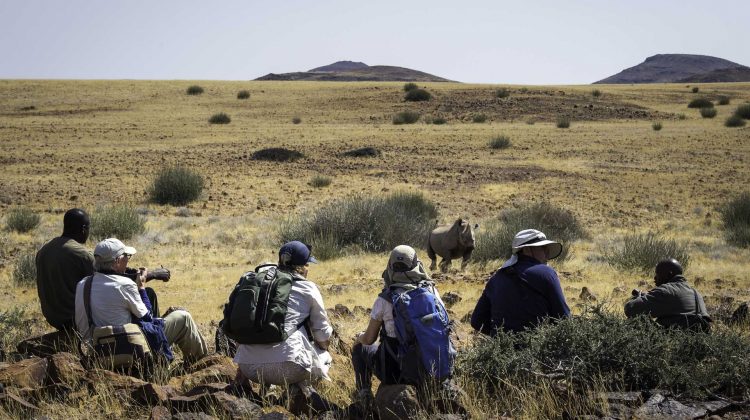
We sit on the deck overlooking the dry riverbed warming ourselves in the morning sun. The whole family is dressed in muted colours as we wait for our guide to return with news. He left early, before sunrise and the delivery of coffee to our tents, to meet the rhino rangers and see which springs had been visited overnight and where we would start our tracking.
Searching for rhino
As we wait, my two teenage children test the Swarovski binoculars which have been loaned to us. Huab Under Canvas, the camp we are staying in, has a partnership with the Austrian company. Their guides all have a pair of the famously good binos and we’ve got some to use while we stay here. Although I like my Nikon’s, I have to admit these are a couple of levels above what I normally use.
There’s not much to look at in terms of wildlife. Although we are alongside a riverbed with springs that are still flowing, Namibia’s drought has been hard on this area, and the few animals that would have been around, including springboks and hyena, have mostly moved to find food elsewhere. But, the scarcity of water that’s reduced the general wildlife, has concentrated the free roaming black rhino. There are currently more rhino in the area than there have been for many years, taking advantage of the springs overnight and then grazing on plants rejected by other animals during the day.
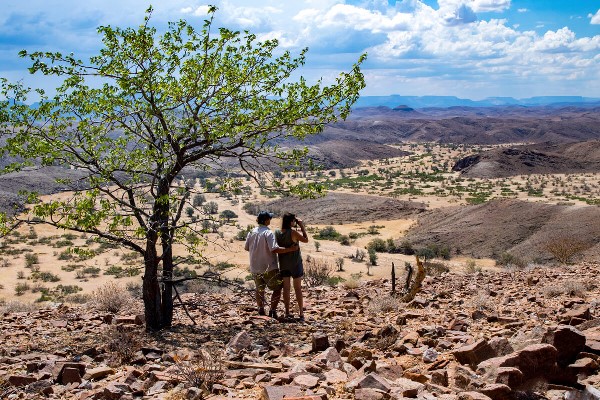
Stunning Damaraland scenery close to Huab Under Canvas
By 11 am with the sun rapidly gaining height in the clear sky, we’d each removed a couple of layers of clothing. François was finally back with the vehicle and it was time to go. We’d heard stories of other visitors who’d been back after tracking at the time we were leaving to head out and I’d begun to worry that we’d be the guests who meant the high rhino success record was lowered.
Half a dozen rhino rangers, supported by Huab Under Canvas, had been out since first light visiting the springs used by the rhino in the hope of picking up tracks. One of the springs had had four overnight visitors, including a mother and calf who travel together, and this was the starting point from the rangers who were now following on foot.
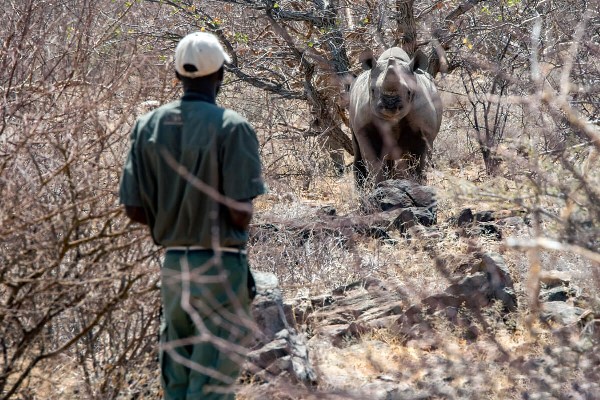
Found you. Although, unfortunately, not on our visit.
Attempt 1
Rhino ranger Denzil rode in the front passenger seat of our Land Cruiser directing François in an effort to get us as near to his colleagues as possible. Roads could only get us so close and we were soon bumping cross country, glad of the off road suspension and rugged tyres. At the top of a hill we were gradually joined by other rangers. Each was keen to get a drink of water, having been out on foot in the sun for over four hours.
The ‘desert adapted’ rhino had added ‘elusive’ to their description during the morning and each of the tracks the rangers had followed had seemingly disappeared in the rocky terrain. It was time for a Plan B and we all headed back to base to have lunch before we tried again.
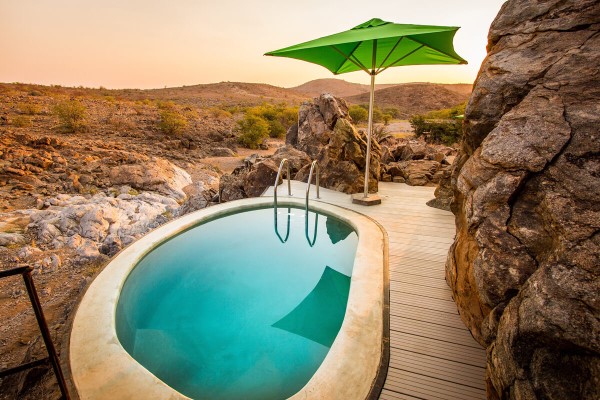
The pool – perfect for a quick dip during the heat of the day
Attempt 2
Full of lunch and cooler after a dip into the frigid pool (their temperature stays cold due to evaporation apparently) we head out again. The value of the camp to the wildlife and communities in the area shouldn’t be underestimated. While for most that’s not going to be a primary reason for a visit, it’s a wonderful legacy of a stay and the money that goes back into supporting the conservancy.
This time we pick up all the rangers from their basic camp and they split between inside and on top of the vehicle, using the luggage rack as a vantage point.
We follow some tracks in the sand, near to one of the springs, but they’re old and soon run out as we get into the rocks. We cross wildlife paths looking for footprints and then head to a high point to look for rhinos or signs of rhinos on the neighbouring hillsides. Despite ten pairs of eyes, five trained, one guide’s and four sets belonging to enthusiastic amateurs, there’s no happy ending. At least not involving a black rhino.
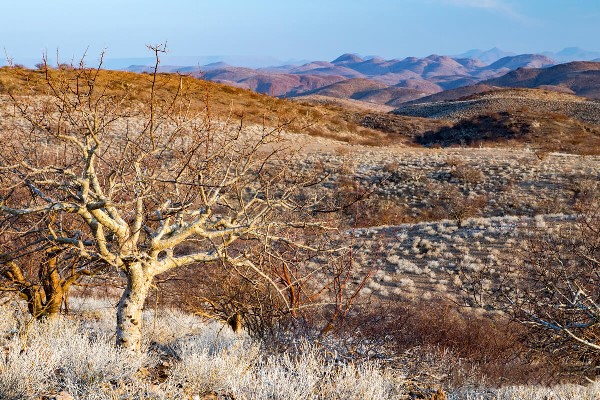
They’re out there somewhere!
While we’ve reduced the percentage success rate for finding rhinos, our day hasn’t been entirely wildlife free or without enjoyment. We saw a super male kudu with five females on our afternoon drive, as well as ostriches on the skyline. There was a wonderful sunset and we marvelled at the drive of the rangers, living in tiny tents in the middle of nowhere and heading out day after day to look for, and look after, what my wife described as ‘truly needles in one of the world’s biggest haystacks’.
Postscript: Although Richard and his family were unlucky on their stay the vast majority of clients visiting the area do get good rhino sightings. Other camps to try include Desert Rhino Camp and Epako Safari Lodge. Let us know if you would like more information.
Leave a Reply